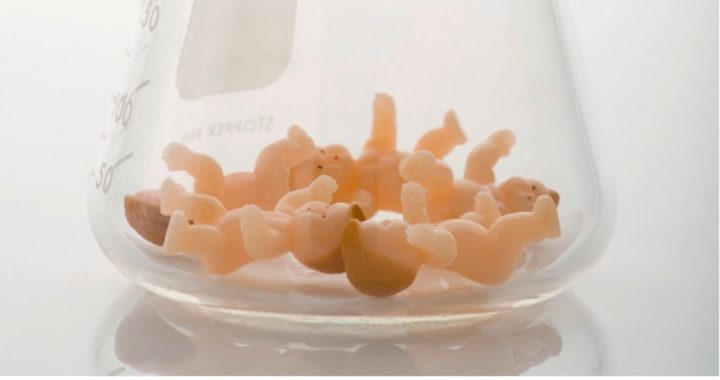
“Hey, it’s a whole new you.” Sometimes uttered after a person has lost weight or made some other major physical improvement, the statement may take on new meaning with a technology one Chinese scientist says is already a reality: the capacity to clone a person. In fact, says Xu Xiaochun, chief executive of Boyalife Group and the mastermind behind the world’s largest “cloning factory,” his company refrains from replicating humans only for fear of public backlash.
And cloning is already becoming big business, with the also controversial matter of replicating animals front and center. As RDMag.com reports:
Sinica, a subsidiary of Boyalife Group, has signed a deal to establish a $31 million commercial animal cloning facility in Tianjin, China, with the intent to produce beef cattle, racehorses and other animals.
According to Xu Xiaochun, the board chairman of Boyalife Group, the plant will initially produce 100,000 cattle embryos per year, eventually increasing its output to 1,000,000 per year.
… Chinese scientists, according to Boyalife Group, have been cloning sheep, cattle and pigs since 2000. In September 2014, Boyalife and Sooam Biotech opened the first commercial cloning company in China’s Shandong Province. The first animals produced were three pure-blooded Tibetan mastiff puppies.
Cloning is a cut-to-the-chase version of selective breeding. Breeders would for centuries take a dog species and breed only the individuals exhibiting desired traits, thus increasing those traits’ prevalence in the species over time. With cloning, however, you can simply take a most desirable canine and “voila!” Replicate him and you have a whole population of “perfect pets.” The cloning of dogs has already been done, mind you, for people who wanted their favorite canine to “live on” (many find this creepy).
Moreover, genetic engineering can take this trait selection further. “Designer” gene technology can enable scientists to alter a genetic blueprint so as to create an animal with desired characteristics. So alter the genome, replicate, and you can have an army of Superdogs (though not quite like Krypto).
Most people find this unsettling. Yet all new technologies can be used for evil or good, and genetic manipulation is no exception. For example, species driven to extinction by man’s activities (e.g., the Dodo) could be resurrected via cloning, just as the 1993 film Jurassic Park portrayed the re-creation of creatures extinct due to natural phenomena; in fact, the Tianjin facility will, reports the AFP, “house a gene bank capable of holding up to approximately five million cell samples frozen in liquid nitrogen — a catalogue of the world’s endangered species for future regeneration.” As for man, birth defects and genetic conditions — such a cleft lip, Down syndrome, and spina bifida — could be remedied in utero via gene technology.
Yet human cloning and other genetic-engineering applications can be a reality as well. As the AFP also writes:
Boyalife is already working with its South Korean partner Sooam and the Chinese Academy of Sciences to improve primate cloning capacity to create better test animals for disease research.
And it is a short biological step from monkeys to humans — potentially raising a host of moral and ethical controversies.
“The technology is already there,” Xu said.… The firm does not currently engage in human cloning activities, Xu said, adding that it has to be “self-restrained” because of possible adverse reaction.
But social values can change, he pointed out, citing changing views of homosexuality and suggesting that in time humans could have more choices about their own reproduction.
“Unfortunately, currently, the only way to have a child is to have it be half its mum, half its dad,” he said.
“Maybe in the future you have three choices instead of one,” he went on. “You either have fifty-fifty, or you have a choice of having the genetics 100 per cent from Daddy or 100 per cent from Mummy. This is only a choice.”
So from the pre-natal murder of the “wrong” baby to the creation of the “right” one, the pro-choice theme will no doubt be repeated.
And it appears that people have already been cloned. The Daily Mail reported last year that “Chinese scientists have created at least 30 cloned human embryos as a source of cells for medical treatments.” China has a “relaxed attitude” toward cloning, as the paper put it, but this is no surprise from a nation that harvests and sells executed prisoners’ body parts. This is relevant because, as Dr. Seuss told us when we were little, “A person’s a person, no matter how small.”
People generally are disgusted by the idea of stealing a person’s body parts and profiting off them, but what’s occurring with the “embryos”? Some will say that at issue is a very different stage of development, but where does one draw the line if not at conception? If it’s moral to use the early-stage human called an embryo in such a manner, what about an individual one second older? And what about one second older than that? Then there’s another second… Carry it forward, and the proposition becomes plain: One second (whatever it may be) it’s wrong to steal a person’s body parts, but the second before it was just fine and dandy. And carry it forward enough, and you can justify the involuntary harvesting of adult body parts, as the Chinese do. Perhaps we can at least praise them for their consistency.
Then there’s the matter of human “gene editing.” How alluring will it be for a person of means to, instead of leaving his prospective child to the lottery of life (conception involves 3.1 billion possible combinations), order up a 6′3″, drop-dead handsome Adonis of a son with a genius I.Q.?
Scientists and activists have, in fact, just recently warned of this application. As the Centre for Genetics and Society Executive Director Marcy Darnovsky put it, “The worst-case scenarios are pretty horrific: a genetics arms race between nations or within societies, a world in which affluent parents purchase the latest set of upgrades for their offspring, leading to the emergence of genetic ‘haves’ and ‘have nots.’”
To place this in further perspective, consider the Nazis’ WWII-era Lebensborn program. Its goal was to create babies with desirable Aryan traits via eugenics, the science of improving man through selective breeding. Eugenics, quite popular in the early 20th century, was discredited precisely because of the Nazis’ activities. But what was the difference between their actions and today’s proposals?
The Nazis aimed to create “designer babies.” Note that this is precisely the term used today to describe children who would be custom made via genetic engineering. But while WWII-era scientists had to rely on selective breeding to cultivate people with the desired genes, now geneticists can select the desired genes in the laboratory. Thus, the only difference between the Nazis’ Lebensborn and today’s designer dreams is technology; as with the dogs, we can now “cut to the chase.”
But we’d best be careful that the dream we chase isn’t a nightmare. People are people, no matter how small. And science used wrongly is still wrong, no matter how big the technology.



